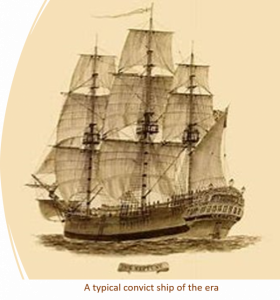WILLIAM READING
Subject Name: William Reading (b.1813–d.1886)
Researcher: Jo Patrick
William Reading’s freedom ended abruptly after his foolish decision to pilfer from his employer saw him transported to Van Diemen’s Land for seven years, but eventually found the means to return to his home village.
Twins William and Samuel Reading were born in West Clandon just outside Guildford on 12th December 1813 to parents Benjamin and Mary (née Howick), and were baptised as Protestant Dissenters. Why they were baptised in this way is not known as Benjamin and Mary’s first child Frederick was baptised in West Clandon’s St Peter and St Paul Church in 1809.
No further records of the family have been found until William’s father Benjamin’s second marriage to spinster Ann Paul on 23rd July 1823 in St Mary’s Church, Lambeth. What had become of William’s mother Mary has not been traced.
By the Spring of 1827, 13-year-old William had two young half-siblings, Benjamin and Ann, along with the rest of his family, so it was not long before he decided to head to London where a silly mistake two years later would see his life take a dramatic and unforeseen turn.
William had found employment with umbrella and parasol maker William Black, and was working as an errand boy with Black’s associate Mark McLachlan close to the Tower of London. This all came to an abrupt end on 14th October 1829, when 15-year-old William was arrested for stealing umbrella caps from his employer.
The case went to the Old Bailey where William appeared before Mr Justice Park on 29th October. He was accused of stealing on 6th October 1829 144 brass caps from Black and then trying to sell them below face value to another umbrella maker, Moses Cohen. At the trial, Cohen said that he had recognised William as being in the employ of Black so two days later, he had taken the caps to Black who confirmed that they were his.
In William’s defence, Black told the jury that William had been employed by him for almost two years and that ‘his character was very good, till lately he was very fond of going to the Theatres, and I told him he could not do it with my wages’. William submitted a petition to the Crown to have his sentence reduced, but without success. William, noted as 16 in the Old Bailey records but actually more than a month short of that birthday, was found guilty and sentenced to 7 years transportation to Van Diemen’s Land (re-named Tasmania in 1856).
Transportation seems an extremely harsh form of punishment for what could be seen as a relatively minor and probably first offence for William. However, the British Government wanted to establish successful colonies in Australia, so the majority of the 162,000 convicts transported there between 1788 and 1868 were only guilty of petty crimes and were therefore expected to be able to help build the new colony.
William was imprisoned in Newgate Gaol until he sailed with 199 other convicts on the convict ship Manlius which left Sheerness on 23rd April 1830. Remarkably, the journal of the travelling surgeon Mr E Johnson recorded no fatalities during the voyage, the ship arriving safely in Hobart on 12th August.
Van Diemen’s Land had been the site of British penal colonies since 1803. When 16-year-old William arrived, he was not sent to the notorious Port Arthur penal settlement where the hardened criminals were housed. As a first-time offender, he would have been sent to either a probation station in which convicts were involved in public works such as road building, or he would have been assigned to live and work with a settler to work on their farm.
William’s record described him as a house servant from London, age 17 – he was still adding a year – 5 feet 1 ¼ inches (1.56m) tall with red hair, brown eyes and a crucifix tattoo on the inside of his right arm. Although full details of William’s placements are not available, records of his behaviour certainly are – “neglect of duty”, “disobedience of orders” and “incorrigible idleness” charges all appear against his name. These resulted in periods of 7-10 days of solitary confinement or a similar amount of time on the tread wheel, both of which were conducted on a diet of just bread and water.
Worse was to follow on 29th June 1836, when William was caught stealing two pence (less than 1p) from his master John Archer, resulting in six months being added to his seven-year sentence. This still didn’t seem to deter William, as on 21st January 1837, he was discovered “drinking and gambling in his master’s kitchen and strong suspicion of robbing Mr Tetley’s store” as well as “pilfering wine from his master’s house”. His punishment was 12 months hard labour in a chain gang, which consisted of a large group of convicts working while chained together with heavy leg irons.
William was made part of the Grass Tree Hill chain gang, which was charged with constructing the Grass Tree Hill Road near Richmond, just north of Hobart. A charge of “idleness” was brought against him on 22nd March 1837, but this was the last misdemeanour noted against him, so the authorities decided to release William a few weeks early from the six months additional sentence that had been given to him.
Most convicts at that time remained in Australia as returning home to England had to be paid for by themselves which very few could afford. William, however, was different, and somehow managed to fund his return to West Clandon. We have no record to show how he found the money to pay for a ticket or when he boarded a ship home, but more than ten years after completing his sentence, William and his twin Samuel, age 34, were baptised in West Clandon’s St Peter and St Paul Church on 20th August 1848. Having been originally baptised as non-conformists, it’s a matter of speculation why they chose to do this – perhaps it was seen as a way to celebrate with their family William’s unexpected return from Australia.
Three years later, William was listed on the 1851 census as lodging in Temple Court, on the nearby Clandon Park estate, owned by the 3rd Earl of Onslow. William was 38, unmarried, and noted as a “servant ag lab”. The grounds of Clandon Park had been designed by the renowned landscape gardener Lancelot “Capability” Brown and would undoubtedly have been seen as a good place to live and work. In the 1861 Census, William was still living there, but was now employed as a groom.
By 1871, William, now 57, was lodging at The Bull’s Head in West Clandon, just a few hundred metres from Clandon Park. William was noted as a labourer although probably not at Clandon Park, as he was no longer living on the estate.
William’s health may have been a factor in causing him to leave Clandon Park, as on 3rd November 1875, he was admitted to the Brookwood Mental Hospital from Guildford Union Workhouse with “melancholia” and a “weakly” bodily condition. An excerpt from his notes in the hospital case book says ‘… [William] is despondent and low, harassed by strange fancies and had thoughts which constantly prompt him to do away with himself’. The doctor had also made a note that a friend of William, Richard Danes, told him that William had tried to commit suicide two years previously.
Perhaps his mental health had worsened when he got news of his twin brother’s death in 1873 at the age of 60. Samuel, a widower, had been admitted to the Camden Union workhouse and discharged to its Infirmary in Highgate several times in the previous three years. William’s only other surviving full relative, his older brother Frederick, had also recently died, in 1874 age 67, in Richmond.
William stayed at Brookwood for 13 days before being discharged as ‘not improved’. Although there are no records to prove it, it seems most likely that in his condition, he would have returned to the Guildford Union and remained there for the rest of his life, as he had no immediate family of his own to care for him.
The 1881 Census listed William as an inmate of the Guildford Union. He died there six years later on 13th September 1886 age 74, and was buried on 17th September at West Clandon’s St Peter and St Paul Church.
October 2019, updated April 2022
Sources : Ancestry.co.uk, Ancestry.com
British Literature Wiki
Britishnewspaperarchive.co.uk
Convict Records of Australia
Findmypast.co.uk
Guildford Register Office
General Register Office
Libraries Tasmania
Oldbaileyonline.org
Surrey History Centre
The National Archives National
Wikipedia.org
Full references available here.
